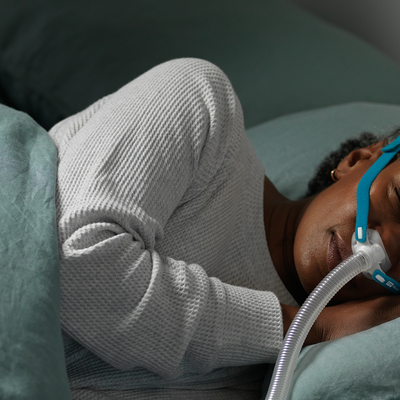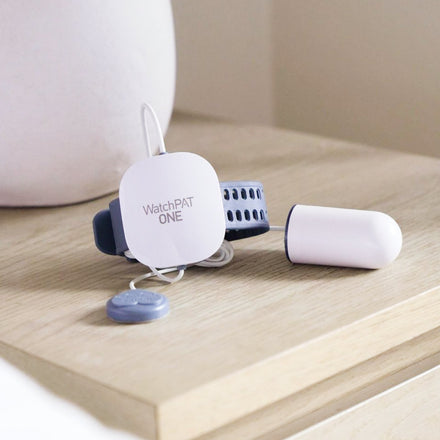Sleep apnea is a sleep disorder that indicates temporary lapses in breathing as a person sleeps. As a consequence of abnormal breathing, a person may experience low-quality sleep, daytime sleepiness and fatigue, and long-term health issues.
The causes, symptoms, and treatments of irregular breathing during sleep depends on the type of sleep apnea a person may have. Here we’ll lay out a sleep apnea overview, including key distinctions between the three sleep apnea types.
Obstructive Sleep Apnea vs. Central Sleep Apnea vs. Mixed Sleep Apnea
Obstructive Sleep Apnea (OSA)
OSA occurs when the throat airway is completely or partially blocked as you breathe during sleep. The causes for an obstructed airway are many, but the result is the same: temporary, repeated pauses or slowing of the breath.
Because OSA is the significantly more common form of sleep apnea, it’s simply referred to as “sleep apnea.” The terms OSA, sleep apnea, and Obstructive Sleep Apnea are used interchangeably; when we say “sleep apnea,” we’re referring specifically to OSA.
Central Sleep Apnea (CSA)
Central Sleep Apnea (CSA) occurs when the brain transmits incorrect signals to muscles that control breathing. As a result, your body briefly stops or slows its breathing.
CSA is less common than OSA, and it does not involve a blocked airway. Instead, it’s related to the function of your central nervous system (hence the “central” of central sleep apnea). CSA is typically linked to an underlying medical condition, such as stroke, heart failure, neuromuscular disease, pain medications, or brain infection or tumor, that can damage the brain stem and disrupt the body’s normal breathing process.
Mixed Sleep Apnea
Mixed sleep apnea occurs when a person has both OSA and CSA. Cases of mixed apnea are most often treated like OSA. A person with mixed sleep apnea may exhibit signs of OSA, but once they are treated with CPAP to remove their airway obstruction, they may still show signs of sleep apnea. Other terms for mixed sleep apnea are “treatment-emergent central sleep apnea” and “complex sleep apnea” (CompSA).
What Are the Warning Signs of Sleep Apnea?
The “warning signs” of sleep apnea vary by condition. However, there is some crossover between OSA and CSA symptoms.
Warning Signs of OSA and CSA
- Disrupted breathing during sleep
- Sleep deprivation or lower-quality sleep
- Fatigue or excessive daytime sleepiness
- Difficulty concentrating or thinking clearly
- Irritability or mood changes
- Morning headaches
- Snoring
CSA symptoms can also include waking abruptly, followed by shortness of breath. A person with CSA may also have insomnia or difficulty staying asleep.
While people with CSA can snore, snoring is more common for people with OSA. Therefore, common warning signs of OSA are loud, chronic snoring, choking or gasping during sleep, waking up from choking or gasping, sore throat or dry mouth in the morning, and daytime sleepiness.
If OSA goes untreated, the condition can increase risk for long-term complications, such as high blood pressure, heart disease, kidney disease, heart failure, Type 2 diabetes, and cognitive and behavioral disorders. It can also contribute to daily hazards, like accidents at work or falling asleep behind the wheel!
How Do I Know If I Have Sleep Apnea?
In addition to the “warning signs” of sleep apnea, certain health and lifestyle factors increase the likelihood of developing sleep apnea.
For OSA and CSA, shared risk factors include …
- Age: Though sleep apnea can occur at any age, risk of development increases with age.
- Gender: OSA and CSA more commonly occur in men.
- Heart failure and stroke: Prior stroke, kidney disease, or congestive heart failure increases the risk of OSA and CSA.
Additional risk factors of CSA include taking opioid medications that can cause irregular breathing or sleeping at high altitude.
On the other hand, risk factors that are specific to OSA include ..
- Anatomy: The size and position of a person’s neck, tonsils, facial bone structure, etc. can narrow the airway or block the flow of air through the nose and throat. Nasal congestion from allergies can also put a person at greater risk for OSA.
- Weight: Excess weight and obesity significantly increases the risk and severity of sleep apnea. In fact, weight gain and obesity are indicators of sleep apnea in adults.
- Gender: While men are more likely to develop both OSA and CSA, women increase their risk of OSA if they are overweight or experience menopause.
- Family history: A person is more likely to develop OSA if one or more of their close relatives also has OSA.
- Use of sedatives: Alcohol and sedative medications and drugs relax the throat muscles, potentially obstructing the airway.
- Smoking cigarettes: Smoking can increase inflammation in the upper airway, which means that heavy smokers have a higher rate of OSA than non-smokers.
- Medical conditions: Stroke and congestive heart failure can increase risk for both OSA and CSA. Meanwhile, OSA is more likely to develop among people with diabetes, high blood pressure, heart disease, and chronic. Parkinson’s disease, chronic lung disease (like asthma), and hormonal disorders (like hypothyroidism and Polycystic ovary syndrome) can also increase the risk of OSA.
If you recognize risk factors and warning signs of sleep apnea, talk to a doctor. They can discuss your medical history, medications, and family history to rule out reasons not related to sleep apnea that could be causing your symptoms. The doctor can also administer a physical exam or refer you for a sleep study that monitors your at-sleep breathing patterns for one night. Based on your sleep study results, which can be done at a sleep lab or at home, a doctor can then confirm a diagnosis and provide a treatment plan.
How to Cure Sleep Apnea Naturally at Home without CPAP
Because OSA and CSA derive from abnormal breathing during sleep, they can exhibit similar symptoms. However, they have very distinct causes — and therefore very different treatments.
OSA, the most common form of sleep apnea, is treatable. Lifestyle changes — such as losing weight, treating nasal allergies, curbing smoking and use of sedatives — are “natural” ways to minimize airway obstructions that lead to OSA. They can help treat mild cases of OSA, and they can even curb the impact of more severe OSA.
However, the most effective long-term strategy for treating moderate to severe OSA is CPAP therapy. A CPAP device regulates the flow of air through your airway, allowing you to breathe without disruption or obstruction. The type of CPAP device you use depends on your needs, preferences, and the severity of sleep apnea. That’s why your doctor will provide a prescription and treatment plan if you are diagnosed with OSA.
CSA treatment, on the other hand, typically involves management of the underlying medical condition that causes abnormal breathing at night. In some cases, CPAP therapy can help people with CSA or mixed CSA.
So, if you suspect you have sleep apnea, start with a home sleep test. During the process, you’ll take a one-night sleep test at home, share the results with a doctor, and receive an official diagnosis. If you are diagnosed with sleep apnea, the doctor will also provide you with a treatment plan that can ease your symptoms and cure your sleep apnea.
Make informed decisions about your sleep health by reading our resource on the importance of sleep apnea testing, and our detailed guide on at-home sleep apnea testing, including it's benefits and working.











































